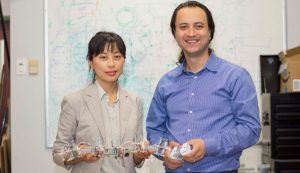Overview
The goal of this project is the creation of soft, snake-like robots that can navigate through real environments with confined spaces, fragile objects, clutter, rough and/or granular surfaces. This project is lead by Prof. Cagdas Onal (PI) from WPI Soft Robotics Lab and Prof. Jie Fu (Co-PI) from Control and Intelligent Robotics Lab (CIRL). Specifically, we plan to develop adaptive and robust control for the soft snake robotics given the difficulty-to-model dynamics. We will investigate learning-based control and stochastic planning to enable the snake robot effectively interacting with obstacles, and autonomously navigating under uneven and open environments under high-level, complex task specifications. When successful, we expect to deploy such a system for geo-exploration and search-and-rescue.
The theory and methods developed with this project could provide new methods to control soft robotics, with applications to safe human-robot interaction.

Team Members:
Renato Gasoto, Yinan Sun, Xuan Liu, Cagdas Onal, Jie Fu
Learning to Locomote
In this paper, we present a new locomotion control method for soft robot snakes. Inspired by biological snakes, our control architecture is composed of two key modules: A deep reinforcement learning (RL) module for achieving adaptive goal-reaching behaviors with changing goals, and a central pattern generator (CPG) system with Matsuoka oscillators for generating stable and diverse behavior patterns. The two modules are interconnected into a closed-loop system: The RL module, acting as the “brain”, regulates the input of the CPG system based on state feedback from the robot. The output of the CPG system is then translated into pressure inputs to pneumatic actuators of a soft snake robot. Since the oscillation frequency and wave amplitude of the Matsuoka oscillator can be independently controlled under different time scales, we adapt the option-critic framework to improve the learning performance measured by optimality and data efficiency. We verify the performance of the proposed control method in experiments with both simulated and real snake robots.
GPU-enabled Simulator for a soft robotic snake
In this work, we present a framework that is capable of accurately representing soft robotic actuators in a multiphysics environment in real-time. We propose a constraint-based dynamics model of a 1-dimensional pneumatic soft actuator that accounts for internal pressure forces, as well as the effect of actuator latency and damping under inflation and deflation and demonstrate its accuracy a full soft robotic snake with the composition of multiple 1D actuators. We verify our model’s accuracy in static deformation and dynamic locomotion open-loop control experiments. To achieve real-time performance we leverage the parallel computation power of GPUs to allow interactive control and feedback.
Sponsor: National Science Foundation

The work is also supported by NVIDIA

Related publications:
- Xuan Liu, Renato Gasoto, Cagdas Onal, Jie Fu, “Learning to Locomote with Deep Neural-Network and CPG-based Control in a Soft Snake Robot”, submitted to RAL & IEEE International Conference on Robotics and Automation (ICRA), 2020.
- Renato Gasoto, Miles Macklin, Xuan Liu, Yinan Sun, Kenny Erleben, Cagdas Onal, Jie Fu, “A Validated Physical Model For Real-Time Simulation of Soft Robotic Snakes”, accepted by IEEE International Conference on Robotics and Automation (ICRA), 2019.
- Renato Gasoto, Jie Fu, “Efficient Reinforcement Learning With Parametric State Clustering”, submitted, 2018.
- Erik Skorina, Ming Luo, Weijia Tao, Fuchen Chen, Jie Fu, Cagdas Onal, “Adapting to Flexibility: Model Reference Adaptive Control of Soft Bending Actuators”, IEEE Robotics and Automation Letters, 2017, accepted.
Media:
- “WPI designing robotic snake for post-disaster searches“,
- “WPI Researchers Developing Autonomous Snake-like Robots to Support Search-and-Rescue Teams“, October 18, 2017.

